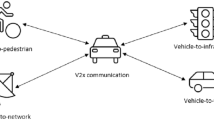Abstract
This paper deals with applying stacking dilated convolutional autoencoder beamforming for Terahertz wave Vehicular ad-hoc networks. A novel solution is proposed to determine the vehicle’s position by big data techniques and deep learning algorithms. Novelty in the solution is obtained via stacking dilated convolutional autoencoder and it is used to train the vehicle traffic datasets.The vehicles direction information is stored in the database for beam alignment. Beam alignment process is used to find the location of vehicles from the database. Multi resolution codebook based beamforming is introduced for finding the vehicles direction information using beam alignment. The proposed terahertz band vehicle propagation model is employed in Vehicular ad-hoc network and results are obtained to determine accuracy and loss curve in multiple operating environments. This model is used to find the vehicles location information using stacking dilated convolutional autoencoder and codebook based beam alignment. Using the traffic dataset, the vehicles’ location information is trained using deep learning algorithm. The dataset is useful for finding out the vehicle’s location information using codebook-based beam alignment. In this article, the vehicles misinformation detection algorithm is also proposed and it is analyzed, where the proposed method gives improved performance in comparison to the existing method with random selection thereby contributing to achieve secure transmission. The research results obtained through this novel approach can be used as benchmark for analyzing and developing TeraHertz Vehicular-Adhoc Networks.










Similar content being viewed by others
Data Availability
https://ai.stanford.edu/~jkrause/cars/car_dataset.html. The authors declare that data supporting the findings of this study are available within the article.
References
Levinson, J., et al. (2011). Towards fully autonomous driving: Systems and algorithms. In Proceedings of 2011 IEEE intelligent vehicles symposium, pp. 163–168.
Kenney, J. B. (2011). Dedicated short-range communications (DSRC) standards in the United States. Proceedings of IEEE, 99(7), 1162–1182.
Araniti, G., Campolo, C., Condoluci, M., Iera, A., & Molinaro, A. (2013). LTE for vehicular networking: A survey. IEEE Communications Magazine, 51(5), 148–157.
Choi, J., Va, V., Gonzalez-Prelcic, N., Daniels, R. C., Bhat, C. R., & Heath, R. W., Jr. (2016). Millimeter-wave vehicular communication to support massive automotive sensing. IEEE Communications Magazine, 54(12), 160–167.
Cailean, A.-M., Cagneau, B., Chassagne, L., Popa, V., & Dimian, M. (2014). A survey on the usage of DSRC and VLC in communication-based vehicle safety applications. In 2014 IEEE 21st Symposium on Communications and Vehicular Technology in the Benelux (SCVT), pp. 69–74.
Wang, J., et al. (2009). Beam codebook based beamforming protocol for multiGbps millimeter-wave WPAN systems. IEEE Journal on Selected Areas in Communications, 27(8), 1390–1399.
Hartenstein, H., & Laberteaux, K. P. (2008). A tutorial survey on vehicular ad hoc networks. IEEE Communications Magazine, 46(6), 164–171.
Cheng, X., Fang, L., Hong, X., & Yang, L. (2017). Exploiting mobile big data: Sources, features, and applications. IEEE Network, 31(1), 72–79.
Schmidhuber, J. (2015). Deep learning in neural networks: An overview. Neural Networks, 61, 85–117.
Jiang, C., Zhang, H., Ren, Y., Han, Z., Chen, K.-C., & Hanzo, L. (2017). Machine learning paradigms for next-generation wireless networks. IEEE Wireless Communications, 24(2), 98–105.
Xu, H., Kukshya, V., & Rappaport, T. S. (2002). Spatial and temporal characteristics of 60-GHz indoor channels. IEEE Journal on Selected Areas in Communications, 20(3), 620–630.
Priebe, S., & Kürner, T. (2013). Stochastic modeling of THz indoor radio channels. IEEE Transactions on Wireless Communications, 12(9), 4445–4455.
Rangan, S., Rappaport, T. S., & Erkip, E. (2014). Millimeter wave cellular wireless networks: Potentials and challenges. Proceedings of the IEEE, 102(3), 366–385.
Priebe, S., Jacob, M., & Kürner, T. (2014). Angular and RMS delay spread modeling in view of THz indoor communication systems. Radio Science, 49(3), 242–251.
Ayach, O. E., Rajagopal, S., Abu-Surra, S., Pi, Z., & Heath, R. W. (2014). Spatially sparse precoding in millimeter wave MIMO systems. IEEE Transactions on Wireless Communications, 13(3), 1499–1513.
Priebe, S., Jacob, M., & Kurner, T. (2011). AoA, AoD and ToA characteristics of scattered multipath clusters for THz indoor channel modeling. In Proceedings of European Conference on Antennas Propagation, Rome, Italy, pp. 188–196.
Trees, H. L. V. (2002). Optimum array processing: Part IV of detection, estimation, and modulation theory. Wiley.
Haupt, R. L. (2010). Antenna arrays: A computational approach. Wiley.
Balanis, C. A. (2005). Antenna theory: Analysis and design. Wiley.
Funding
Not available.
Author information
Authors and Affiliations
Corresponding author
Ethics declarations
Conflict of interest
No potential competing interest was reported by the authors.
Additional information
Publisher's Note
Springer Nature remains neutral with regard to jurisdictional claims in published maps and institutional affiliations.
Rights and permissions
About this article
Cite this article
Ananthi, G., Sridevi, S. Stacking Dilated Convolutional AutoEncoder Beamforming for THz Wave Vehicular Ad-Hoc Networks. Wireless Pers Commun 126, 2985–3000 (2022). https://doi.org/10.1007/s11277-022-09848-y
Accepted:
Published:
Issue Date:
DOI: https://doi.org/10.1007/s11277-022-09848-y




